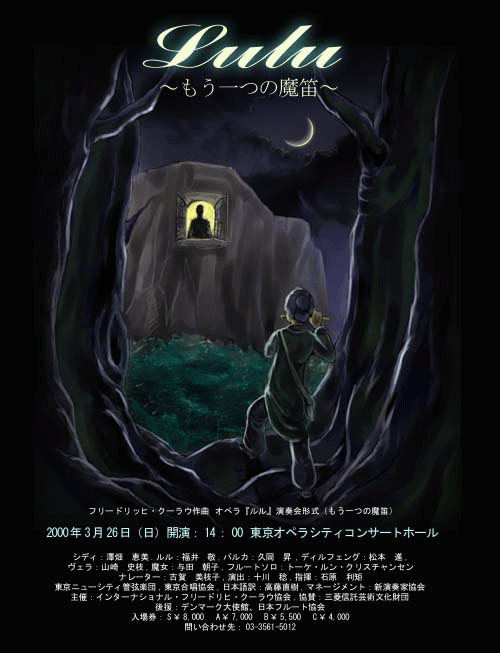First things first: This Danish opera, completed by Friedrich Kuhlau in 1824, has nothing to do with Lulu the femme fatale in the better-known opera of the same title by Alban Berg and the Frank Wedkind plays that inspired it.
Kuhlau's Lulu, which made its Japanese debut on March 26 at Tokyo Opera City Concert Hall in a concert performance, is romantic fairy opera in which Prince Lulu rescues an entrapped princess with the help of a magic flute. Yes, you guessed right: The opera has roots in common with Mozart's Magic Flute - namely, German fairy tale "Lulu oder die Zauberflöte" (Lulu or the Magic Flute).
If you have seen the Mozart opera, you will have noticed that, despite the title, the "magic flute" is hardly as central to the opera as the title would suggest. Although the hero Tamino plays the instrument several times, the flute has only a minor role in creating the denouement in a story undertoned with the mysticism freemasonry.
But in Lulu, the flute is far more central - musically as well as dramatically. Sprinkled here and there in the work are virtuoso flute cadenzas, artfully provided by celebrated Danish flutist Toke Lund Christiansen, who also participated in the first and only recording of the opera.
Kuhlau (1786-1832) is for the Danes almost what Handel is for the British. Both composers were born in Germany but spent the latter half of their lives in their adopted countries and became something of national figures.
In Japan, Kuhlau's name is often associated with only a handful of his sonatines, which allmost every paino student learns at a young age. But listning to Lulu, with its keen dramatic sense and echoes of Rossini and Beethoven, one realizes the work comes courtesy of a truley skilled composer, one who was very much the child of his time.
It is largely thanks to the efforts of conductor Toshinori Ishihara, the chairman of the International Kuhlau Society, that the performance exudes the kind of liveliness that convinces you the opera is not one of those "rediscovered" mediocre works, but somthing worthy of being fully staged in the future.
In the forest of the fairy Periferihme, Lulu chases away a tiger that has been harassing shepherds and their flocks. Shepherdess Vela tells him that her friend, Princess Sidi, and her magic rosebud is in the hands of sorcerer Dilfeng. As Lulu resolves to rescue her, Periferihme, Sidi's mother, gives him a migic flute capable of enchanting all who hear it and a magic ring that enables the owner to metamorphose into anything he likes.
Disguised as an old man, Lulu plays the flute within earshot of the castle of the sorcerer, who invites our hero inside, thinking his music will win over Sidi, who he wants to make his bride. Alone with Sidi, Lulu reveals his true self and they start to fall in love.
Meanwhile, Dilfeng is making preparations for his and Sidi's wedding. Lulu plays the flute again, making all the bad characters fall asleep, thus allowing him to take back the rose that is destined to bloom only when Sidi finds true love, giving her power over the spirits of nature into the bargain. At this point, Dilfeng awakens and conjures up a storm as a last-ditch attempt to bring everyone down with him.
Under Ishihara's passionate baton, the Tokyo New City Orchestra played with gusto while Tokyo Choral Society's 20 men and women supplied solid hormonies.
The six soloists, who song and spoke occasional dialogue in a Japanese translation by Naoki Takafuji, included some of finest opera singers in Japan, such as Kei Fukui as Lulu. Fukui's lyrical voice was perfect for the young and aspiring prince. And so was Emi Sawahata's crystal-clear soprano for Sidi.
Susumu Matsumoto as Dilfeng and Noboru Hiasaoka as his son, the dwarf Barca, made a colorful duo with contrasting voice - Matsumoto's ringing bass with almost no vibrato and Hisaoka's a dramatic baritone with efective, and at times comical, use of vibrato.
Asako Yoda made an excellent witch with her rich contralto, but soprano Fumie Yamazaki sounded somewhat thin as Vela.
One of virtues of the performance was Ishihara's substantial yet sensible cuts. Remember, this was not staged performance, and without the cuts it would have taken well over three hours excluding intervals.
Another winning factor was the apointment as director of Minoru Togawa, who smoothed out the work's dramatic structure. Actress Mieko Koga served as narrator to fill the dramatic gaps between scenes and also read the part of Periferihme. In addition, the lighting effect were subtle yet effective - such as flickering light behind the organ pipes on the backwall of the auditorium to accompany the thunder storm.
The performance marked the second time the opera has been heard outside Denmark. The first was a performance in Darmstadt, Germany, last summer. |
